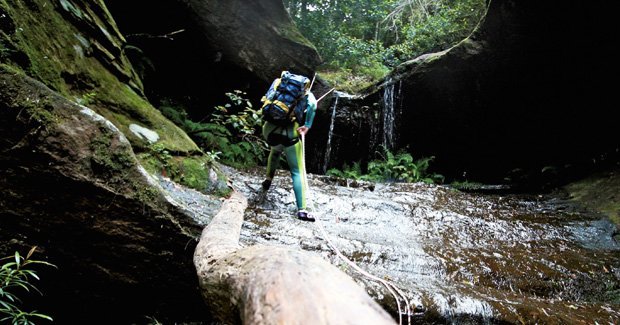The Australian Geographic Adventure guide to canyoning

Canyoning involves following a free-flowing river through gorges, waterfalls, caves, canyons and whatever else arises from nature. In order to do this you’ll be walking, scrambling, jumping, abseiling and swimming. One thing’s for certain – you’re going to get wet!
James Castrission is an avid climber and canyoner and a regular contributor to Outdoor Australia. We managed to pull him from the Blue Mountains long enough to get his expert tips on canyoning.
Top Tips
• When starting out, go down a canyon with either a guide, tour group or other experienced canyoner, and if in a group, keep the numbers down to a maximum of eight.
• Tie long hair out of the way to stop it from being caught in the abseil device. Even my shoulder-length hair has been caught in my abseil device a few times.
• If there is a pool to swim through, lie on your rucksack or push it in front of you rather than having it on your back.
• Don’t be afraid over edges you are abseiling off, to use your shins and knees to get closer to the wall.
• Bums down! To get down overhangs, try and get your bottom as far over the edge as possible before letting your feet come down.
• Expensive canyoning shoes are great – but Dunlop Volleys or the $10 K-Mart wetsuit reef walker booties are just as fantastic!
• The weather is boss. If the forecast is for rain, or the clouds look a little ominous on your way out to the canyon – leave it for another day, as heavy rain can turn the most benign canyon into a rushing torrent. The canyon will always be there.
• Mossy rocks can be difficult to negotiate. Don’t be afraid to slide over these sections on your bum. This will lower your centre of gravity and add more friction – you’ll feel much more comfortable.
• As your skills improve so will your appetite for more difficult canyons. The difficulty of a canyon is based on its ease of access, awkwardness of abseils, commitment levels and difficult navigation.

Technique
The Approach
There is often a decent hike to the start of a canyon. Wear a dry set of clothes down to the start of the canyon. Before committing to the first abseil, stuff your dry clothing into a dry bag and put your canyoning clothing on (if it’s a wet canyon, this means a wetsuit).
Getting Ready To Abseil
Once in the canyon, there will likely be a number of abseils. These abseils will either be off tree trunks, artificial anchors or chockstones. In most beginner canyons there will be tape around the abseil point. Thread the rope through the tape to the halfway point. Before abseiling, always check and recheck the anchor – just because other people have gone down before you, there is no room for complacency. If some of the tat looks worn or tired, add some tape of your own and tie a tape knot.
Abseiling
As a beginner, put a prusik knot on the rope or have the person that abseiled before you belay you from the bottom. When you get to the bottom of the abseil yell “Off Rope!” so that the next person can come down. Once the whole party is down, pull one end of the rope quickly and smoothly. Ideally, the most experienced canyoners in the group should be the first and last down.
Glossary of Terms
Anchor: Any temporary, secure point that a canyoner uses to abseil off.
Belay: Controlling the rope that is fed out to the climber or abseiler.
Chockstone: A rock or boulder wedged into a narrow canyon or crack.
Figure 8: The preferred abseil device for beginners, used for descent on a rope. If you’ve never seen one – it looks like its name implies!
Prusik: A funky knot used for ascending a rope and providing a backup when you are abseiling.
Static Rope: A non-elastic, non-stretchy rope; preferred for abseiling and canyoning.
Hot Spots
1. Blue Mountains, NSW
This region has some of the world’s best canyoning. Favourite beginner canyons include Grand Canyon and Tiger Snake. As you can take on more difficult canyons try Butterbox and Kanangra.
Where: 100 km west of Sydney
Website
2. Tuross Falls, NSW
Some easy to moderate grade canyoning here with fantastic swimming at the Cascades, a water-polished granite slippery slide. Weekend expeditions are easy with free camping. Located in the Wadbilliga National Park.
Where: 150 km southeast of Canberra
Website
3. Karajini Gorges, WA
Try this one with a tour company – it’s graded as a Class 6. Get your thrills on some knox slides, down narrow chutes and waterfalls.
Where: 190 km southeast of Port Hedland
Website
Equipment Checklist
- Harness
- Helmet
- Figure 8
- Prusik
- 60 m static rope
- Wetsuit
- Headwear
- Canyoning shoes (or Dunlop volleys/wetsuit booties)
- Spare tape
- Dry bags
- Canyoning guide
- Small rucksack
- First aid kit
- Torch






